![]()
Aroids and other genera in the Collection
Take the Tour Now?
Orchids
The
Exotic Rainforest
Plants in
the Exotic Rainforest Collection
Monstera siltepecana Matuda
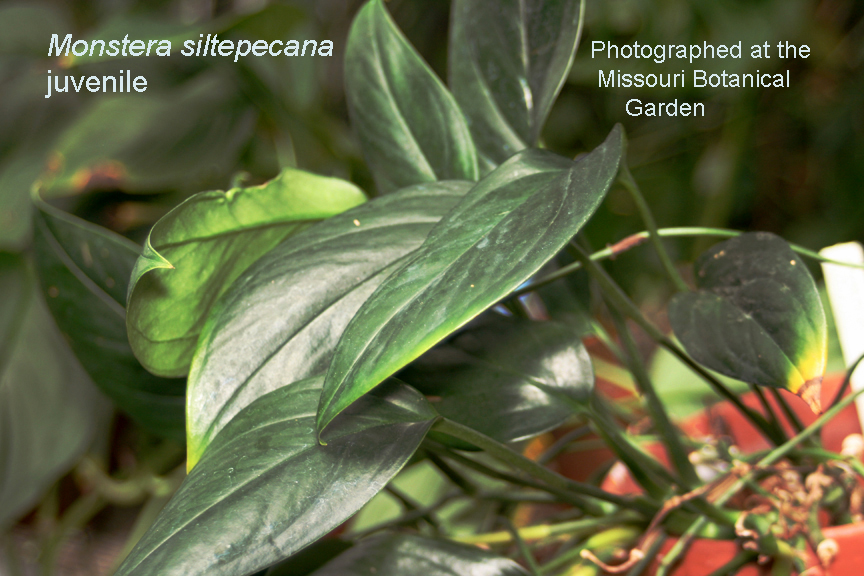
and other names including "Philodendron karsteniana" which is also an invalid name never published to science.
Occasionally known as
Not the plant you are looking for? See also Monstera pinnatipartita
Monstera siltepecana was described to science in 1950 and is
one of only 35 currently accepted species of Monstera
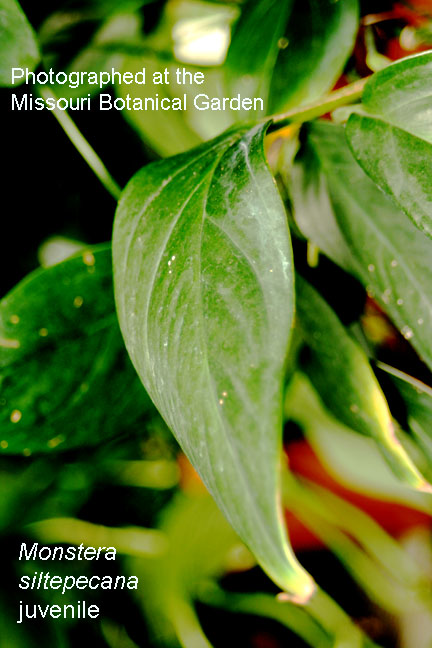 known to science. However, the
genus is presently under study and new species are expected to soon be
described. Monstera species often have numerous variations and as a result, numerous synonym names (same
plant, other scientific name) are sometimes used.
known to science. However, the
genus is presently under study and new species are expected to soon be
described. Monstera species often have numerous variations and as a result, numerous synonym names (same
plant, other scientific name) are sometimes used.
This species is very confusing to collectors since a variety of sources claim the plant shown on this page is not the species. We deliberately planned a trip to the Missouri Botanical Garden in late April of 2010 to coincide with a meeting of the International Aroid Society in hopes we could sort out the confusion. The plant above was photographed directly in the aroid research greenhouse with the identification taken directly from a tag with information provided by aroid botanist Dr. Tom Croat.
Monstera siltepecana has been
collected in Chiapa, Mexico, Belize, Colombia, Costa Rica, El Salvador, Guatemala, Honduras,
Nicaragua, and Panama. The juvenile specimens of
Monstera siltepecana do not have holes in their leaves since those
fenestrations (window-like holes) develop as a specimen matures. This
species name can sometimes be found as a synonym of Monstera
friedrichsthalii but that information does not appear to be accurate
since Monstera friedrichsthalii is now a synonym of Monstera
adansonii and is no longer an accepted species. You can confirm on that
information on Royal
Botanic Garden
Kew scientific
sites such as CATE Araceae.
Monstera
siltepecana
See
Monstera
adansonii on this site for details.
Every aroid in the genus
Monstera is a Neotropical species. The Neotropics or
Neotropical zone is one of eight terrestrial ecozones found on
planet Earth and includes South and Central America, southern Mexico, the
Caribbean, and
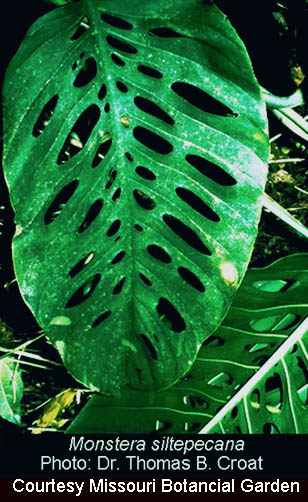 extreme southern Florida. Despite the
belief Monstera species are found in Asia they are not native to
any country on the Asian continent. There
are however related genera in
Asia
since the genus Monstera as well as the genera
Rhaphidophora,
Epipremnum, Amydrium and
Scindapsus are
all are found in
the same aroid tribe which
is Monsterea.
The juvenile form of this plant has been incorrectly identified as
Monstera dilacerata
which is a synonym of the Asian species
Epipremnum pinnatum,
a fact confirmed by aroid botanist Pete
Boyce on April 11, 2010. Pete is personally responsible for detecting
the errors involved with Monstera dliacerata
which was originally collected in Asia but incorrectly tagged before it
was granted a scientific name.
extreme southern Florida. Despite the
belief Monstera species are found in Asia they are not native to
any country on the Asian continent. There
are however related genera in
Asia
since the genus Monstera as well as the genera
Rhaphidophora,
Epipremnum, Amydrium and
Scindapsus are
all are found in
the same aroid tribe which
is Monsterea.
The juvenile form of this plant has been incorrectly identified as
Monstera dilacerata
which is a synonym of the Asian species
Epipremnum pinnatum,
a fact confirmed by aroid botanist Pete
Boyce on April 11, 2010. Pete is personally responsible for detecting
the errors involved with Monstera dliacerata
which was originally collected in Asia but incorrectly tagged before it
was granted a scientific name.
Monstera siltepecana is an appressed epiphyte. Appressed aroids are those that closely "hug" the host tree) and grows as a climbing vine sometimes referred to as "shinglers" when in their juvenile stages.
Don't fall into the trap of assuming the juvenile form of a plant species will look exactly like the adult. Aroid species including the genus Monstera are extremely variable. Natural variation is common within many plant species and it is estimated one out of every eight plants known to science are variable. Not every leaf blade will always look alike. This link will explain in non-technical language natural variation and morph genesis (ontogeny) within plant species. Click here
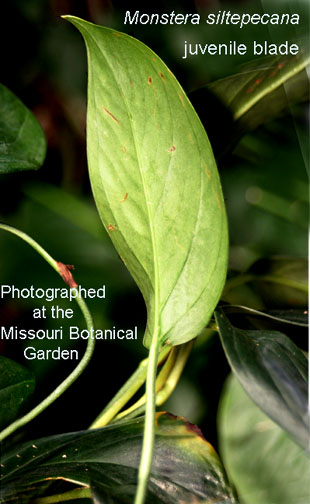 The leaf blades
of a juvenile Monstera siltepecana are somewhat bluish but as they
mature become dark green as well as semi-glossy The
species grows as an epiphytic creeper. An epiphyte (ep-a-FIT) is a plant that
grows upon another plant. The leaf blades are slightly coriaceous to
sub-coriaceous (less than leathery) and the major veins of a leaf blade are
whitish on the blade's underside. The underside of
the leaf
blades are also slightly bi-colorous.
The leaf blades
of a juvenile Monstera siltepecana are somewhat bluish but as they
mature become dark green as well as semi-glossy The
species grows as an epiphytic creeper. An epiphyte (ep-a-FIT) is a plant that
grows upon another plant. The leaf blades are slightly coriaceous to
sub-coriaceous (less than leathery) and the major veins of a leaf blade are
whitish on the blade's underside. The underside of
the leaf
blades are also slightly bi-colorous.
A common species in its native range, the caudex (an enlargement of the stem) is a dark shiny green. The petioles which support each leaf blade are sharply canaliculate (sulcate or grooved) and slightly speckled as well as glaucous (shiny) at the base. The new petioles also possesses petiolar sheaths. Petiole sheaths are greenish white extensions on each side of the petiole's upper surface that appear similar to wings that envelope the successive newly developing leaf blade. However, in Monstera siltepecana these sheaths are deciduous and drop form the petiole as it ages.
The stem of a plant is not the stalk that supports a single leaf but is the base, central axis and main support of a plant which is divided into nodes and internodes. The nodes produce a complete leaf including a petiole in the axil of which they produce roots and hold buds which may grow into shoots of various forms. The stem's roots anchor the plant either to the ground or a tree. In the case of Monstera siltepecana the stem hugs (presses close) to the host plant as it climbs and is known as being appressed.
The stems of some species may also spread as a repent rhizome creeping across the soil or may either grow above ground, underground or partially above the soil.
A photo of the intermediate adult leaf blade of Monstera siltepecana
can be see on the website of aroid botanist David
Scherberich:
Monstera
siltepecana More adult
Monstera forms can be seen on David's site here:
Monstera.html
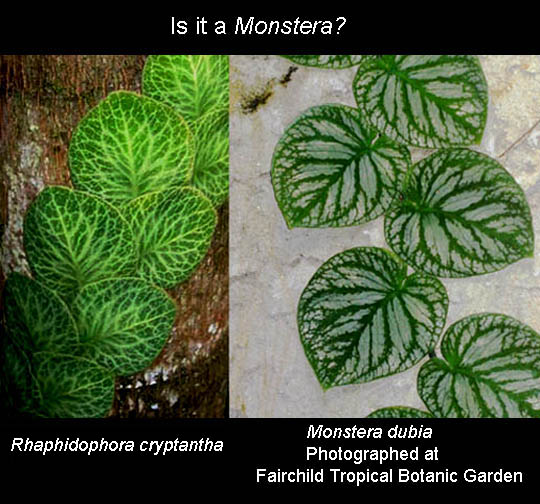 All Monstera
species are aroids. An aroid is a plant that
reproduces by producing an inflorescence known to science as a
spathe and
spadix. Most people believe the spathe is a "flower", but it is not.
The spathe is simply a modified leaf with a spadix at its center on
which
the true flowers (very tiny) grow. If pollinated by an appropriate
insect, the spadix will
eventually
produce berries which contain seeds. The
spathe is a bluish-green and the spathe's margins (edges) are ruffled and
greenish-white in color. The spadix is pale green.
All Monstera
species are aroids. An aroid is a plant that
reproduces by producing an inflorescence known to science as a
spathe and
spadix. Most people believe the spathe is a "flower", but it is not.
The spathe is simply a modified leaf with a spadix at its center on
which
the true flowers (very tiny) grow. If pollinated by an appropriate
insect, the spadix will
eventually
produce berries which contain seeds. The
spathe is a bluish-green and the spathe's margins (edges) are ruffled and
greenish-white in color. The spadix is pale green.
As is apparent from the photos at the top of this page of the juvenile form, those fenestrations may take several years to develop as a "house plant". As Monstera siltepecana begins to mature it morphs into a plant that looks quite different than the juvenile form. At some point in the ontogeny (morph genesis) of the species the plant becomes multi-lobed. As can be seen in our photo (right, below) our specimen is just begging to develop fenestrations (small holes). Fenestrations in Latin means "windows".
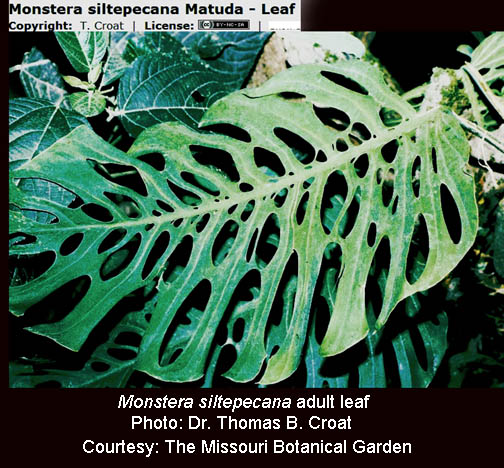 Monstera species are
members of the larger plant family Araceae commonly known as aroids. An
aroid is a plant that reproduces via the production of an inflorescence
known as a spathe and spadix. Although growers often believe the
spathe is a "flower" the spathe
is simply a specially modified leaf whose purpose is to protect the spadix
at its center.
Monstera species are
members of the larger plant family Araceae commonly known as aroids. An
aroid is a plant that reproduces via the production of an inflorescence
known as a spathe and spadix. Although growers often believe the
spathe is a "flower" the spathe
is simply a specially modified leaf whose purpose is to protect the spadix
at its center.
The spathe does not
qualify as a flower since it possesses no sexual parts. All flowers
have pistils, stigmas ,ovaries, ovules, stamens and anthers. Without those
sexual parts a flower has no way to be fertilized or reproduce. A
spathe possesses none of these parts but all can be observed on the spadix
at its center.
The spadix appears as a spike on a thickened fleshy axis which does in fact produce tiny flowers. When ready to reproduce the spadix of a Monstera produces perfect flowers which contain both male, female and sterile male organs. The purpose of the sterile flowers is to produce a perfume-like substance known as a pheromone which attracts the appropriate pollinating insects but it also serves as a source of protein for the visiting insect pollinators by producing lipids.
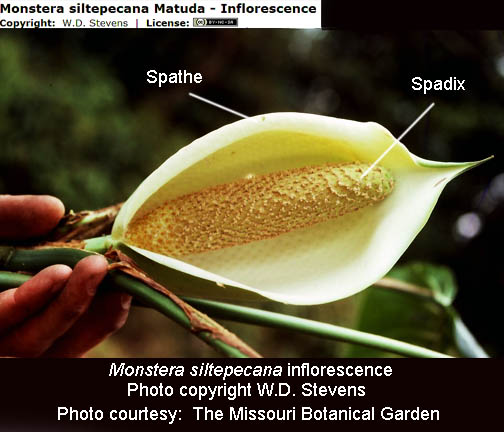 Monstera
species differ from Philodendron species since Philodendron produce
imperfect flowers which contain only male or female sexual organs.
Monstera
species differ from Philodendron species since Philodendron produce
imperfect flowers which contain only male or female sexual organs.
The sterile male flowers entice pollinators which are normally
small beetles from the genus Cyclocephala by sending out their
pheromones (perfume) on the breeze which floats through the forest. Those beetles
gather pollen from another member of the same Monstera genus and
bring it to the female flowers while being enticed to fly to the source of
warmth and food in the coolness of the rain forest evening. The beetles can
"see" the inflorescence since it produces both a scent and a "glow" in the
form of infrared heat which is suspected to be visible to a special receptor
on the end of their antennae.
If you are interested in
a more detailed account of how aroids reproduce please visit this link:
Natural and artificial pollination in aroids.
The colors in the photos courtesy of the Missouri Botanical Garden are not accurate since they were duplicated. This species is known to be variable and not every leaf of every plant will look exactly alike! This link will give you an easy to understand explanation of the natural variation within plant species: Natural variation.
Want to learn more
about aroids?
Join the
International Aroid Society:
http://www.exoticrainforest.com/Join%20IAS.html